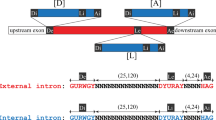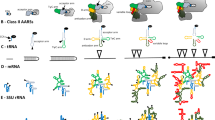Abstract
Introns are common in the rRNA gene loci of fungal genomes, but biochemical studies to investigate splicing are rare. Here, self-splicing of a very small (67 nucleotide) group I intron is demonstrated. The PaSSU intron (located within the rRNA small subunit gene of Phialophora americana) splices in vitro under group I intron conditions. Most group I ribozymes contain pairing regions P1–P10, with a conserved G·U pair at the 5′ splice site, and a G at the 3′ intron border. The PaSSU intron contains only P1, P7, and P10. While it contains the G·U pair at the 5′ splice, a U is found at the 3′ end of the intron instead of a G. Phylogenetic analysis places it within subgroup IC1, whose members are found in the nuclear rRNA genes of fungi. The structural elements are similar to those in the centermost regions of other group I introns. Its size can be explained by a single large deletion that removed P2 through much of P9. Part of the original P9 region has assumed the function of P7. Its small size and genealogy makes it an excellent model to study RNA catalysis and evolution.





Similar content being viewed by others
References
Adams PL, Stahley MR, Gill ML, Kosek AB, Wang J, Strobel SA (2004) Crystal structure of a group I intron splicing intermediate. RNA 10:1867–1887
Bhattacharya D, Lutzoni F, Reeb V, Simon D, Nason J, Fernandez F (2000) Widespread occurrence of spliceosomal introns in the rDNA genes of ascomycetes. Mol Biol Evol 17:1971–1984
Cech TR (1988) Conserved sequences and structures of group I introns: binding an active site for RNA catalysis—a review. Gene 73:259–271
Cech TR (1990) Self-splicing group I introns. Ann Rev Biochem 59:543–568
Cech TR, Herschlag D (1996) Group I ribozymes: substrate recognition, catalytic strategies, and comparative mechanistic analysis. Nucleic Acids Mol Biol 10:1–18
Chen W, Lynn EG, Grau CR (1998) Characterization of a group I intron in the nuclear rDNA differentiating Phialophora gregata f. sp. adzukicola from P. gregata f. sp. sojae. Mycoscience 39:279–283
Cubero OF, Bridge PD, Crespo A (2000) Terminal-sequence conservation identifies spliceosomal introns in ascomycete 18S RNA genes. Mol Biol Evol 17:751–756
Davila-Aponte J, Huss V, Sogin M, Cech TR (1991) A self-splicing group I intron in the nuclear pre-rRNA of the green alga, Ankistrodesmus stipitatus. Nucleic Acids Res 19:4429–4436
DeWachter R, Neefs J, Gori A, Van dePeer Y (1992) The gene coding for small ribosomal subunit RNA in the basidiomycete Ustilago maydis contains a group I intron. Nucleic Acids Res 20:1251–1257
Doudna JA, Cech TR (2002) The chemical repertoire of natural ribozymes. Nature 418:222–228
Doudna JA, Cormack B, Szostak JW (1989) RNA structure, not sequence, determines the 5′ splice-site specificity of a group I intron. Proc Natl Acad Sci USA 86:7402–7406
Doudna F, Szostak JW (1989) Miniribozymes, small derivatives of the sunY intron, are catalytically active. Mol Cell Biol 9:5480–5483
Gargas A, DePriest P, Taylor J (1995) Positions of multiple insertions in SSU rDNA of lichen-forming fungi. Mol Biol Evol 12:208–218
Gast RJ, Fuerst PA, Byers TJ (1994) Discovery of group I introns in the nuclear small subunit ribosomal RNA genes of Acanthamoeba. Nucleic Acids Res 22:592–596
Golden BL, Kim H, Chase E (2005) Crystal structure of an active group I ribozyme–product complex. Nat Struct Mol Biol 12:82–89
Good L, Intine RVA, Nazar RN (1997) Interdependence in the processing of ribosomal RNAs in Schizosaccharomyces pombe. J Mol Biol 273:782–788
Grube M, Gargas A, De Priest PT (1996) A small insertion in the SSU rDNA of the lichen fungus Arthonia lapidicola is a degenerate group-I intron. Curr Genet 29:582–586
Guo F, Gooding AR, Cech TR (2004) Structure of the Tetrahymena ribozyme: base triple sandwich and metal ion at the active site. Mol Cell 16:351–362
Gutierrez G, Blanco O, Divakar PK, Lumbsch HT, Crespo A (2007) Patterns of group I intron presence in nuclear SSU rDNA of the Lichen Family Parmeliaeae. J Mol Evol 64:181–195
Ikawa Y, Shiraishi H, Inoue T (2000) Minimal catalytic domain of a group I self-splicing intron RNA. Nat Struct Biol 7:1032–1035
Johansen S, Vogt VM (1994) An intron in the nuclear ribosomal DNA of Didymium iridis codes for a group I ribozyme and a novel ribozyme that cooperate in self-splicing. Cell 76:725–734
Johnson AK, Baum DA, Tye J, Bell MA, Testa SM (2003) Molecular recognition properties of IGS-mediated reactions catalyzed by a Pneumocystis carinii group I intron. Nucleic Acids Res 31:1921–1934
Joyce G (1989) RNA evolution and the origins of life. Nature 338:217–224
Lehnert V, Jaeger L, Michel F, Westhof E (1996) New loop-loop tertiary interactions in self-splicing introns of subgroup IC and ID: a complete 3D model of the Tetrahymena thermophila ribozyme. Chem Biol 3:993–1009
Michel F, Westhof E (1990) Modeling of the three-dimensional architecture of group I catalytic introns based on comparative sequence analysis. J Mol Biol 216:585–610
Michel F, Hanna M, Green R, Bartel D, Szostak J (1989) The guanosine binding site of the Tetrahymena ribozyme. Nature 324:391–395
Murphy FL, Cech TR (1993) An independently folding domain of RNA tertiary structure within the Tetrahymena ribozyme. Biochemistry 3:5291–5300
Murphy FL, Cech TR (1994) GAAA tetraloop and conserved bulge stabilize tertiary structure of a group I intron domain. J Mol Biol 236:49–63
Rangan P, Masquida B, Westhof E, Woodson S (2003) Assembly of core helices and rapid tertiary folding of a small bacterial group I ribozyme. Proc Natl Acad Sci USA 100:8788–8792
Rogers SO, Rehner S, Bledsoe C, Mueller GJ, Ammirati JF (1989) Extraction of DNA from Basidiomycetes for ribosomal DNA hybridizations. Can J Bot 67:1235–1243
Rogers SO, Yan Z, Shinohara M, LoBuglio K, Wang CJK (1993) Messenger RNA intron in the nuclear 18S ribosomal RNA gene of deuteromycetes. Curr Genet 23:338–342
Shinohara M, LoBuglio K, Rogers SO (1996) Group I intron family in the nuclear ribosomal RNA small subunit genes of Cenococcum geophilum isolates. Curr Genet 29:377–387
Simon D, Moline J, Helms G, Friedl T, Bhattacharya D (2005) Divergent histories of rDNA group I introns in the lichen family Physciaceae. J Mol Evol 60:434–446
Sung-Oui S, Jones KG, Blackwell M (1999) A group I intron in the nuclear small subunit rRNA gene of Cryptendoxyla hypophloia, an ascomysetous fungus: evidence for a new major class of group I intron. J Mol Evol 48:493–500
Swofford D (2001) PAUP: phylogenetic analysis using parsimony, Version 4. Sinaur Academic Publishers, Philadelphia
Tanner NK (1999) Ribozymes: the characteristics and properties of catalytic RNAs. FEMS Microbiol Rev 23:257–275
White TJ, Bruns T, Lee S, Taylor J (1990) Amplification and direct sequencing of fungal ribosomal RNA genes for phylogenteics. In: Innis MA, Gelfand DH, Sninsky JJ TJ, White TJ (eds) PCR protocols, a guide to methods and applications. Academic Press, Inc., Harcourt Brace Janovich Publishers, New York, pp 315–322
Xiao M, Li T, Yuan X, Shang Y, Wang F, Chen S, Zhang Y (2005) A peripheral element assembles the compact core structure essential for group I intron self-splicing. Nucleic Acids Res 33:4602–4611
Zhang L, Xiao M, Chen L, Zhang Y (2005) Fast formation of the P3–P7 pseudoknot: a strategy for efficient folding of the catalytically active ribozyme. RNA 11:59–69
Zuker M (2003) Mfold Web server for nucleic acid folding and hybridization prediction. Nucleic Acids Res 31:1–10
Acknowledgments
We thank Dr. CJK Wang for providing cultures and identifications of fungi used in this study. LH was partly supported by an assistantship provided by the Center for Biomolecular Sciences at Bowling Green State University. LH thanks MT Iturriaga and L Ryvarden for their helpful discussions of fungal systematics.
Author information
Authors and Affiliations
Corresponding author
Additional information
Communicated by A.J.P. Brown.
Rights and permissions
About this article
Cite this article
Harris, L., Rogers, S.O. Splicing and evolution of an unusually small group I intron. Curr Genet 54, 213–222 (2008). https://doi.org/10.1007/s00294-008-0213-y
Received:
Revised:
Accepted:
Published:
Issue Date:
DOI: https://doi.org/10.1007/s00294-008-0213-y




